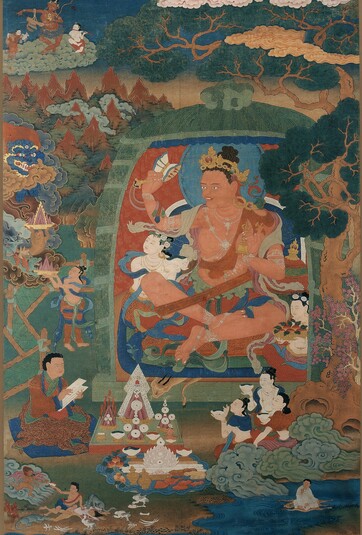
Item: Indian Adept (siddha) - Maitripa
| Origin Location | Tibet |
|---|---|
| Date Range | 1800 - 1899 |
| Lineages | Drukpa (Kagyu) and Buddhist |
| Material | Ground Mineral Pigment on Cotton |
| Collection | Private |
Classification: Person
TBRC: bdr:P44
The Great Indian Adept: Maitripa
Maitripa (1007-1078) was an Indian Buddhist teacher who studied at both Nalanda and Vikramashila Monasteries. At Nalanda he studied with the famous teacher Naropa, however at Vikramashila during the tenure of Atisha, he was expelled because of his behaviour. After leaving the monastic life he lived and practiced as an ascetic yogi. Meeting with the great mahasiddha Shavaripa, Maitripa took him as a principal teacher and studied the special techniques of Mahamudra. He was looked upon as a greatly accomplished one of the Buddhist Tantric system (mahasiddha) and is most famous for teaching the Mahamudra philosophy and practice to the Tibetan translator Marpa Chokyi Lodro - the equally famous teacher of Milarepa.
The central figure of the composition is Maitripa, seated slightly to the right of the central axis of the composition. In the right hand held upraised he beats a double sided drum. In the left hand he rings a bell decorated with a half-vajra handle. Atop the head is a crown of gold and jewels; earrings, a necklace of bone and bracelets and anklets of bone. Supporting the left knee is a red meditation belt. Covering the shoulders a wrapped around the back is a complete human skin, grey and lifeless, pink on the inside. In a relaxed posture, accompanied by two female attendant figures, he sits atop a cushioned seat and the skin of a krishnasara deer, inside a thatched grass retreat hut, hardly accommodating, and not spacious. An inscription in Tibetan language located below reads 'Lord Maitripa, holder of the essence of the teachings.' (nying po bstan 'dzin mnga' bdag me tri pa).
At the top left of the composition, dancing upon a cloud, is the Mahasiddha Shavaripa holding an arrow in the right hand and a vase in the left. Hanging at the elbow of the left arm is his characteristic bow and the quiver of arrows hanging from the elbow of his right arm. Around the waist is a skirt made of peacock feathers. Accompanied by two attendant figures. On the left a man carries the limp bodies of a goat or deer over the right shoulder and a bird on the left. On the right side a is a dancing figure playing a flute. An inscription below the clouds, written in Tibetan language reads 'Glorious Shawari' (dpal sha wa ri).
Seated to the lower left of the central figure Maitripa is Marpa Chokyi Lodro, well wrapped in layered Tibetan clothing and holding a folio text in hand - about to turn the cover page. Placed in front is a table arranged with various stylized food offerings (torma) and two skullcup bowls. Slightly lower in foreground is a textile spread on the ground with an assortment of meats and alcohol arranged for a Tantric Feast (ganachakra) ritual. Three heavenly goddesses arriving on seats of swirling cloud hold skullcup bowls, ready to partake of the ritual feast. Again, at the middle left, an attendant figure makes offerings to the worldly spirits and deities in preparation for the Tantric Feast.
An inscription written below reads 'performing torma (offering) activities at the charnal ground of Blazing Like a Fire.' (me ltar 'bar ba'i dur khrod du gtor ma'i las mdzad pa). to the left of that, at the bottom of the composition is a small vignette of the 'Blazing Like a Fire' charnal ground (cemetery).
At the bottom right, floating on the surface of a blue, slightly turbulent river, sits Milarepa - student of Marpa - atop a deerskin seat wearing his customary attire of a single white cotton robe.
The drawing, colour, and composition of the painting follow the traditional style of Khampa Gar artists from the Lhatog region of Kham in Eastern Tibet. The original Khampa Gar style was developed by the great Drugpa Kagyu artist of the late 17th century named Cho Tashi (exact dates unknown). He was influenced by a number of different painting styles current during his time and came up with his own unique colouring combinations and a completely new style of composition for story-telling in art.
(Written for the publication and exhibition catalogue: Exhibition of Quintessence of Returning Tibetan Cultural Relics from Oversea. Beijing, China, July 2012).
Jeff Watt, June 22nd 2012
Numbered Schematic:
1. Shavaripa, Mahasiddha
2. Maitripa, Mahasiddha
3. Marpa Chokyi Lodro, Translator (Lotsawa)
4. Milarepa
Front of Painting
English Translation of Inscription: [Name inscriptions for each figure and scene]
Publication: Quintessence of Returning Tibetan Cultural Relics From Oversea (Painting)
Thematic Sets
Indian Adept: Maitripa
Subject: Music (Deities Related to Music)
Indian Adept (Mahasiddha): Painting (Late Period 17th to the Present)
Indian Adept: Siddha Appearance (Bird Imagery)
Subject: Drums in Art Main Page
Subject: Tantric Feast (Ganachakra)
Subject: Mahamudra Page
Glossary: Tantric Subjects (Vajrayana)
Indian Adept: Siddha Appearance Masterworks (Painting)
Definition: Mahasiddha (Three Functions)
Subject: Teachers Holding Drums
Subject: Music Main Page
Indian Adept: Mahasiddha Iconography
Collection: Private 10 (Masterworks)
Indian Adept Main Page (Mahasiddha)
Painting Tradition: Lhatog, Khampa Gar
Collection: Private 10





